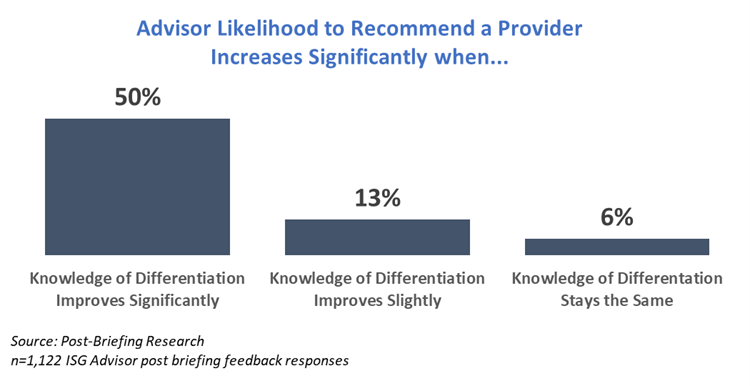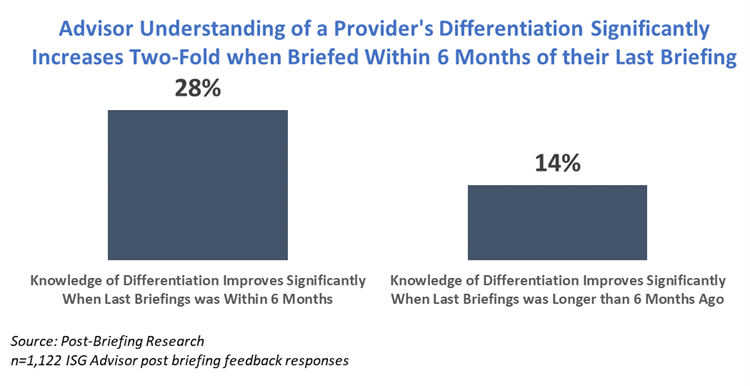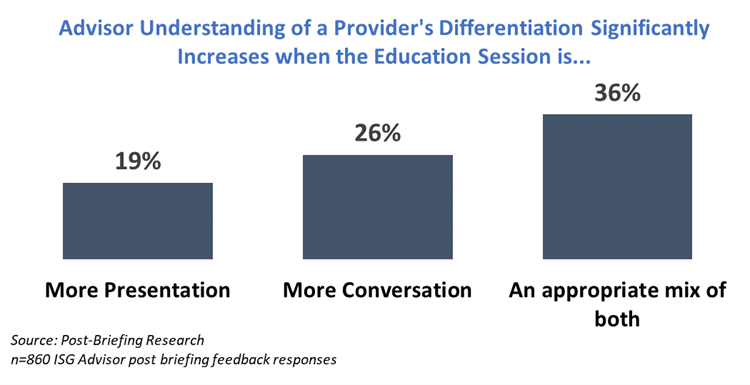Unlocking Business Potential through Effective Differentiation
The overall quality of provider briefings has improved in the last year. Congratulations to our Momentum clients! Improvement has come in two specific areas, overall quality of briefings and, more specifically, with respect to providers’ effectiveness at sharing their differentiation.
| 2023 | 2024 | |
| Overall briefing effectiveness: | 64% | 71% |
| Differentiation effectiveness: | 25% | 32% |
| Source: ISG Post-briefing research | n=645 | n=498 |
Note: Improvement is statistically significant
Why does this matter? When you clearly communicate your differentiation, your likelihood of being recommended to clients improves notably. As the chart below shows, the better your firm can clearly communicate your differentiation, the more likely advisors are to recommend you to their clients. Your firm needs to understand your true differentiators and be sure to incorporate them into your education programs with ISG.

How can providers improve how they communicate their differentiation?
Frequency of Education
I often get asked the question – is it really valuable to educate your advisors more than once a year? Our data shows when advisors get briefed within 6 months of their last briefing their understanding of a provider’s differentiation improves two-fold over advisors briefed more than 6 months prior. Educating advisors about every six months helps them better understand your differentiation. Intuitively this makes sense. The more an advisor sees client examples where your differentiation is on display, the more likely it is that they’re able to recognize the right client fits for your organization.

Style of Presentation
Frequency is not the only variable, however. How you communicate your message is important. We’ve talked in the past about effective advisor education strategies, so I’ll simply say that doing a one-way presentation of your capabilities is the least effective method. Education sessions that are more conversational or a mix of conversation and presentation are far more effective at getting across your differentiation.

To put this in context, we often get briefings where the presenters are trying to get through every slide and consistently ask questions like, “Does that make sense?” This doesn’t really make for a session that is conversational (and more memorable). Consider carefully who is delivering your education sessions and find ways to get the advisors more engaged. An example of this might be to present three case study options and ask them which they’d like to review. When they choose, ask why they chose this case study – do you have clients facing similar issues? Creating this type of exchange lets you ask more questions open-ended questions as you go.
Understanding your true differentiation and sharing it through case studies
As an advisor relations professional, your aim is to aid your team in articulating your firm's differentiation to boost advisors' likelihood of recommending your firm. Unfortunately, providers’ differentiation does not always come across clearly. Case studies continue to be the most effective way for an advisor to really understand what sets you apart from your competitors. Here are some advisor quotes that make this point…
- “There was nothing they discussed that was unique from other Providers, I felt they were limited in their delivery capabilities compared to other providers. Not sure what deals to invite them to.”
- “I'd like to know more about their differentiators, how they have transformed a client in terms of on-prem to cloud transformation and reverse (if any)”
- “It's a very competitive market - would really like to better understand what makes them different from their competitors?”
- “It would be nice to continue to share updates on service offerings and client success stories to stay current on capabilities that continue to grow.”
- “I need to bring home the “how” they differentiate and realize value for its clients.”
We asked our advisors to share specific examples of what they felt were provider’s differentiating factors after their education sessions. In total, advisors provided more than 400 examples of differentiation. Rather than share them all here, ISG GPT was used to create 11 categories of differentiation. You can use this as a guide to find specific areas of differentiation for your firm. As our resident expert on differentiation, Randy Vetter says, “Differentiation is one size fits one, not one size fits all.” Be sure drill into each area to find things unique to your firm and that are defensible.
1. Focus on AI and Innovation: focus on AI, innovation, and digital capabilities.
2. Cloud and Digital Transformation Capabilities: capabilities in cloud and digital transformation, including hosting, cloud adoption, and migration.
3. Industry Knowledge and Experience: deep domain knowledge and experience in specific industries.
4. Customer Centricity and Satisfaction: commitment to customer satisfaction, customer focus, and their ability to understand and meet client needs.
5. Operational Excellence and Quality: operational performance, quality of service, and efficiency.
6. Flexibility and Agility: flexibility, agility, and responsiveness to client needs.
7. Global Reach and Scale: global capabilities, scale of operations, and breadth of services offered.
8. Unique Solutions and Technologies: unique solutions, proprietary platforms, and innovative technologies.
9. Strong Partnerships and Collaborations: strategic partnerships, collaborations, and affiliations.
10. Commercial and Financial Aspects: commercial models, financial benefits, and investment choices of the providers.
11. Case Studies and Proven Experience: demonstrated capabilities through their case studies and proven experiences.
As I’ve highlighted in prior notes, I believe your advisor relations program should have goals each quarter in each of the four elements that are key to getting invited to advised deals, as shown below…
- Data Sharing – sharing capabilities and market success to support long-listing.
- Messaging – develop messaging that is on-point, engaging, and memorable.
- Advisor Education – identify the right mix of advisors to educate.
- Relationship Building – work towards advocacy with all appropriate advisors.
Most providers do not have quarterly goals in each of these areas, and least of all with respect to improving their messaging. I recommend including messaging reviews in your quarterly activities with ISG to ensure your differentiation is clear. Firms that stand still tend to fall behind their competitors.
As always, I’m interested in hearing your thoughts on these ideas. Feel free to drop me a note or give me a call to discuss!
